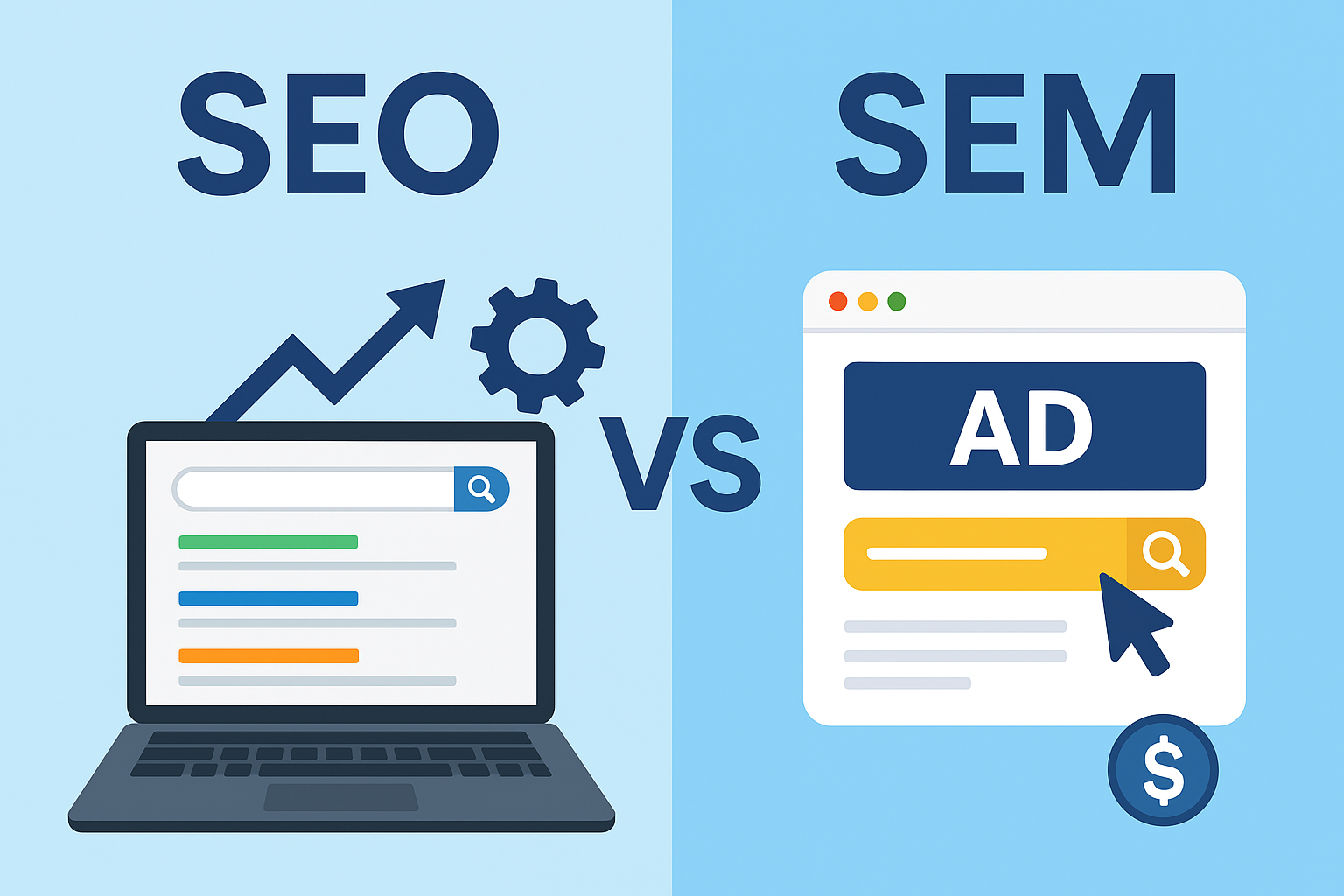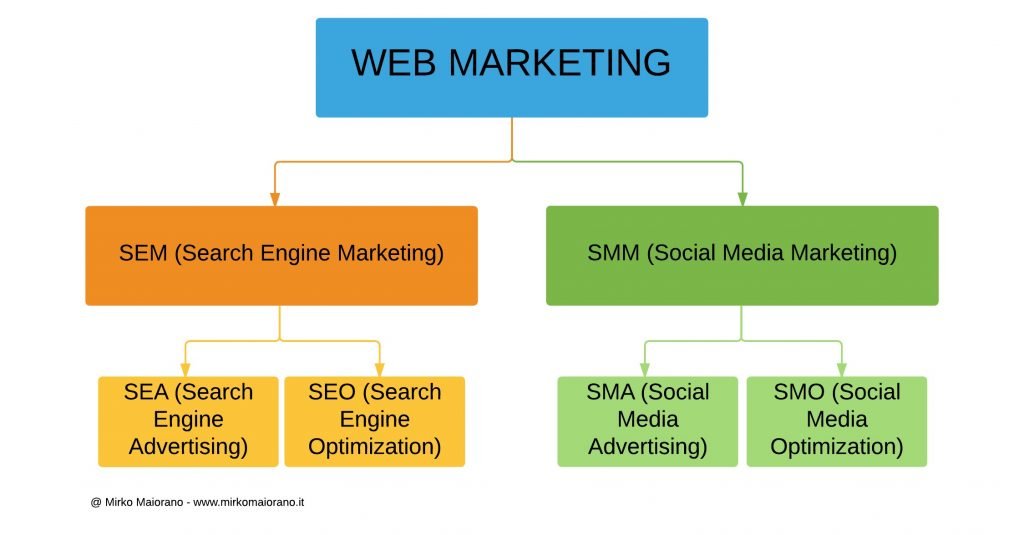Discover SEO vs SEM, the key differences, benefits, and strategies. Learn what is the difference between SEO and SEM to boost your online success.
SEO vs SEM: What’s the Difference & How to Choose the Right Strategy
In today’s competitive digital world, every business wants to be visible on search engines. But when it comes to online strategies, there is always a debate about SEO vs SEM. Many marketers wonder about the difference between SEO and SEM, which approach is better, and how to balance the two.
To clear the confusion, let’s explore both methods, understand the SEO and SEM difference, and see how businesses can benefit by using them strategically.
What is SEO?
SEO stands for Search Engine Optimization. It refers to techniques that improve a website’s visibility in organic (non-paid) search results.
The process of SEO involves three key pillars:
- On-page SEO
- Optimizing content with relevant keywords.
- Using proper meta tags, headings, and structured data.
- Writing valuable content that answers user queries.
- Technical SEO
- Improving page speed, mobile-friendliness, and security (HTTPS).
- Ensuring crawlability and indexability.
- Fixing broken links and duplicate content issues.
- Off-page SEO
- Building backlinks from authoritative sites.
- Social signals and online brand mentions.
The main benefit of SEO is its long-term value. Once your site ranks high, you get steady traffic without paying per click. However, it takes patience, consistent updates, and smart strategies.
What is SEM?
SEM stands for Search Engine Marketing, and it mainly refers to paid advertising through platforms like Google Ads. Businesses pay for their ads to appear on search results for specific keywords.
With SEM, you can instantly show your products or services to people actively searching for them. In short, search engine marketing vs search engine optimization comes down to speed and cost—SEM gives faster results, while SEO builds gradual authority.
Key benefits of SEM include:
- Immediate visibility in search results.
- Precise targeting by location, device, or audience behavior.
- Flexibility to scale campaigns up or down.
But there’s a catch—SEM is short-lived. Once the ad budget stops, so does the traffic.
SEO vs SEM: Key Differences
Understanding the SEO and SEM difference is crucial before choosing a strategy. Here’s how they compare:
| Factor | SEO (Search Engine Optimization) | SEM (Search Engine Marketing) |
| Cost | Investment in content & tools; no per-click charge | Pay-per-click or impression; continuous spend |
| Results | Slow but long-lasting | Instant but temporary |
| Credibility | Organic results often trusted more | Ads marked as sponsored |
| Sustainability | Builds long-term traffic & authority | Stops when budget ends |
| Control | Limited control; depends on algorithms | Full control over targeting & budget |
So, what is the difference between SEO and SEM? SEO earns visibility naturally, while SEM buys it instantly.
When to Use SEO vs SEM
Choosing between SEO vs SEM depends on your goals, budget, and timeline.
- Go for SEO if:
- You want to build brand authority.
- You need sustainable traffic over time.
- You prefer long-term cost-effectiveness.
- Go for SEM if:
- You need immediate visibility.
- You’re running seasonal promotions or product launches.
- You want measurable, short-term results.
- Best Strategy: Combine both. Use SEM for quick wins while SEO works in the background to build lasting growth.
Real-Life Example of SEO and SEM Together
Imagine a small online travel agency.
- To quickly attract customers during holiday seasons, they use SEM campaigns with Google Ads targeting “cheap holiday packages.” This brings instant traffic and bookings.
- Simultaneously, they invest in SEO by publishing blog posts like “Top 10 Holiday Destinations” and optimizing their site. Over time, these pages rank organically and continue to bring traffic even after ad campaigns stop.
This mix shows why businesses shouldn’t see SEO vs SEM as a battle, but as partners in growth.
Why You Need Both SEO and SEM
The difference between SEO and SEM isn’t about picking one over the other. Instead, both work best when used together.
- SEM helps test which keywords convert well. Later, those keywords can be targeted with SEO for long-term ranking.
- SEO improves overall site quality, which can reduce SEM ad costs through higher Quality Scores.
- A combined approach builds both trust (SEO) and reach (SEM).
Challenges of SEO vs SEM
Before making a choice, consider the challenges:
- SEO challenges:
- Algorithm updates may affect rankings.
- Competition for high-value keywords is tough.
- It takes time before you see results.
- SEM challenges:
- Costs can rise quickly in competitive industries.
- Ads may not always build trust like organic results.
- Traffic disappears the moment you stop paying.
Understanding these challenges will help you balance both strategies effectively.
Future of SEO vs SEM
As search engines evolve, both SEO and SEM are becoming smarter:
- SEO trends: AI-driven search, voice search, mobile-first indexing.
- SEM trends: Automated bidding, better targeting through AI, and integration with other platforms.
The line between search engine marketing vs search engine optimization will blur further, but the need for both will remain strong.
Conclusion
The debate on SEO vs SEM will continue, but the truth is that both are essential. The difference between SEO and SEM is simple: SEO builds organic visibility, while SEM buys quick exposure. By understanding the SEO and SEM difference, businesses can use both strategically.
So, what is the difference between SEO and SEM? SEO is about earning traffic over time, and SEM is about paying for instant results. Together, they create a balanced, powerful marketing approach.
If you want long-term success, don’t just choose between them—blend search engine marketing vs search engine optimization to enjoy the best of both worlds.






https://t.me/s/pt1win/48
https://t.me/s/iGaming_live/4782
https://t.me/s/reyting_topcazino/15
https://t.me/of_1xbet/185
https://t.me/s/ef_beef